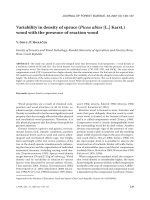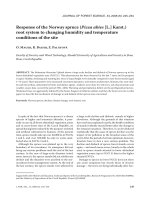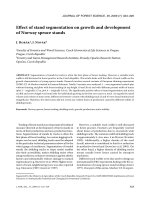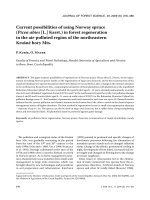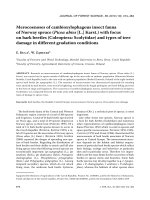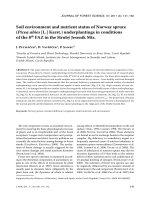Báo cáo lâm nghiệp: "Stability of Norway spruce (Picea abies [L.] Karst.) stands in the Beskid Śląski and Beskid Żywiecki Mts. from the aspect of their nutrition status" pptx
Bạn đang xem bản rút gọn của tài liệu. Xem và tải ngay bản đầy đủ của tài liệu tại đây (200.47 KB, 8 trang )
J. FOR. SCI., 54, 2008 (2): 41–48 41
JOURNAL OF FOREST SCIENCE, 54, 2008 (2): 41–48
e forests of the Beskids Mts., belonging to the Re-
gional Directorate of State Forests in Katowice (RDLP
Katowice), are characterized by a high proportion of
spruce, particularly in their western and southern
parts, which is mainly found in monocultures, is often
of unknown origin and grows at unsuitable sites. In the
Beskid Żywiecki Mts., this species takes up from about
75% to about 95% (on average 85%) of the area of the
state forests. e highest proportion of spruce (over
90%) is found in the forest districts Ujsoły, Węgierska
Górka and Wisła (RDLP Katowice 1996). e propor-
tion of this species in the species composition increas-
es with altitude and for this reason it is so significant
locally also in other administrative units. Moreover, at
high altitudes there are fewer mixed spruce stands and
especially fewer other multi-species stands.
Until the early 1970s, these spruce stands were
considered relatively stable. However, a rapid in-
crease in the air pollution has resulted in tree dam-
age, site contamination and forest biocoenosis im-
poverishment, which has diminished the immunity
of these forests (B 1990; B et al. 1994;
S et al. 1996; B et al. 1999;
Z 2003; M et al. 2005). In this situa-
tion, other anthropogenic and natural factors, both
biotic and abiotic, have intensified their activity syn-
ergistically, increasing the scale of damage. e aim
of the present study is to determine the stability of
spruce stands in the areas of threat to forest stability
in the light of the assessment of their nutrition.
Research area
According to the nature and forest regionalization
of Poland (T et al. 1990), the area of the
present research is located in Carpathian Region
Stability of Norway spruce (Picea abies [L.] Karst.)
stands in the Beskid Śląski and Beskid Żywiecki Mts.
from the aspect of their nutrition status
J. B, S. M
Department of Forest Ecology, Agricultural University of Cracow, Cracow, Poland
ABSTRACT: e aim of the present research was to determine the stability of spruce stands in the areas of threat
to forest stability in the Beskid Śląski and Beskid Żywiecki Mts. in the light of their nutrition. In 2002 samples of soil
and of one- and two-year-old spruce needles were taken from sample plots representing various degrees of the threat
of disintegration to stands. e following factors were determined in soil: reaction, exchangeable acidity, content of
exchangeable cations: Ca
2+
, Mg
2+
, K
+
and Na
+
and the total content of macroelements: C, N, S, Ca, Mg, K and Na.
Very small amounts of alkaline cations were found in the sorptive complex, present also in the chemical composition
of spruce needles where most of the elements under analysis were in the lower zone of the optimum range or below
the threshold values. e results of chemical analyses of spruce needles indicate differences in their content in various
needle ages and a disturbance of their proportions, particularly of N, S, K to Ca and Mg, in the stands under serious
threat of disintegration. ey document the upsetting of mineral economy in spruce, which in turn may influence a
greater susceptibility of this species to stress factors.
Keywords: Norway spruce; soil; needles; macroelements; stability; Beskid Śląski Mts.; Beskid Żywiecki Mts.; Southern
Poland
42 J. FOR. SCI., 54, 2008 (2): 41–48
VIII, Province 1 of the Beskid Śląski Mts. and Beskid
Mały Mts. and partly in Province 4 of the Beskid
Żywiecki Mts.
According to R’s division (1949), the area
of the present research lies in the zone of moun-
tainous climate in the region of the Beskid Śląski
Mts. and Beskid Zachodni Mts. According to H
(1965), it is situated in the moderately cold climate
with a yearly average temperature 4–6°C and pre-
cipitation 1,020–1,150 mm and cold climatic zones
with average temperature 2–4°C and precipitation
1,150–1,350 mm (W 1995). Prevailing winds
are south-western and western; in summer also
north-western. ese winds gain the highest speed
between November and March and can cause great
damage to stands. e spatial distribution of rain
and snowfall in the Beskid Śląski Mts. and in the
western part of the Beskid Żywiecki Mts. depends
on the location of the extended part of this region
with relation to rain-bearing winds from NW and
SW, which is the cause of higher amounts of rain and
snowfall than in the other parts of the Beskidy Mts.
at the same altitudes (K-S et al.
1983). Abundant snowfall may cause damage due to
deposition of snow and ice on tree branches, while
rainfall brings in considerable amounts of industrial
pollution (M et al. 2005). e research area also
witnesses a periodical lack of rainfall, which may
weaken the vitality of spruce and hinder its regenera-
tion (M 1998).
e Beskid Śląski and Żywiecki Mts. are formed
of the Godula nappe. Its constituent types of rock
Table 1. Characteristics of sample plots in the Beskid Śląski and Żywiecki Mts.
Plot No.
Forest District
Compartment
Division
Altitude
(m a.s.l.)
Species
composition
Age
Degree of damage
to spruce crown
Type and subtype
of soil
RS-1 (mixed stable stands)
II Ustroń Brenna 111f 900
6NS, 3EB,
1SF
130 0.87 BRk
XVII
Węgierska
Górka
Lipowa 117f 1,020
8EB, 2NS,
s SM
150 0.89 BRk
XXI Jeleśnia Jeleśnia 180f 1,170 NS, s EB 190 0.97 BRk
RS-2 (stable stands – pure spruce stands)
XIV Bielsko Szczyrk 148k 1,200 NS 110 0.69 BRk sł.b
XXII Ujsoły Ujsoły 17a 1,180 NS 150 1.13 BRk sł.b
RTH (stands under relative threat)
I Ustroń Brenna 111a 900 NS 130 1.38 BRk
III Ustroń Brenna 112g 900 NS 130 1.35 BR sł.b
IV Ustroń Brenna 112h 900 NS 130 1.37 BRk sł.b
XVIII
Węgierska
Górka
Lipowa 118b 1,020 NS 110 1.48 BRk sł.b
XX Jeleśnia Jeleśnia 212d 1,180 NS, s EB 120 1.39 BRk sł.b
XXIII Ujsoły Ujsoły 2a 1,150 NS 80 1.47 BRk sil.b
STH (stands under serious threat)
VIII Wisła Wisła 142c 1,075 NS 100 1.93 BRk sil.b
IX Bielsko Szczyrk 149i 1,125 NS 100 1.71 BRk sil.b
XV
Węgierska
Górka
Lipowa 117b 1,200 NS 80 1.84 BRk sil.b
XVI
Węgierska
Górka
Lipowa 117b 1,200 NS 80 1.89 BRk sil.b
BRk – brown soil, k – acid, sł.b – light podzolization, sil.b – high podzolization; NS – Norway spruce, EB – European beech,
SF – silver fir, SM – sycamore maple, s – single
J. FOR. SCI., 54, 2008 (2): 41–48 43
(M et al. 2000) are quartz-silicate and
carbonate-silicate. At high altitudes, the most
important base of soil is the quartz-silicate series,
consisting of conglomerates and coarse-grain types
of sandstones (mainly the Magura and Istebna
ones), which produce sandy or sand-clayey acid
rock mantle – the base of podzolic soils. is se-
ries is typical of coniferous sites. e rock mantle
of these deposits is rather stony. At high altitudes,
especially on mountain tops and ridges, the rock
mantle is coarse-stony. e water conditions, es-
pecially on tops and ridges and on steep southern
slopes, are worse for demanding spruce and its
saplings (M 1998) than the conditions
on the mantle rock of marl-silicate deposits. e
latter create more favourable water conditions for
plants, especially in areas with small slope reduc-
tion; and they form a substrate for various types of
brown soils. Under homogeneous spruce forests,
they have been variously degraded or have become
podzolic (M et al. 2000).
MATERIAL AND METHODS
Detailed investigations were carried out on the
authors’ own permanent sample plots, set up in ho-
mogeneous spruce stands with the taper of 0.6–0.7
and with different degrees of disintegration threat
as well as in monocultures where disintegration was
already complete. According to the degree of degra-
dation threat, the following groups of sample plots
were distinguished:
– RS – relatively stable stands (RS-1 – mixed stands
with spruce – plots No. II, XVII and XXI; – RS-2
– pure spruce stands – plots No. XIV and XXII
with the degree of crown damage within 0.69 and
1.13), probably of native origin, growing there for
many generations;
– RTH – stands relatively threatened with degrada-
tion (plots No. I, III, IV, XVIII, XX, and XXIII with
the degree of crown damage within 1.35–1.48),
spruce monocultures in the first generation;
– STH – stands seriously threatened with degrada
-
tion (plots No. VIII, IX and XV, with the degree
of crown damage within 1.71–1.93), consisting of
spruce monocultures in the second generation,
with occasional occurrence of beech, mountain
ash and sycamore. e degree of crown damage
was established on each plot from three average
trees cut according to: changes in the length,
shape and colour of needles, number of needles
per shoot and number of needle ages and defolia-
tion, changes in tree vitality, height increment and
canopy shape. e administrative divisions and
the characteristics of site and stand conditions of
these sample plots are presented in Table 1.
In September 2002, mixed soil samples were taken
for chemical analysis from each plot, from the distin-
guished horizons (from 5 subplots). One- and two-
year-old needles were collected from the 7
th
verticil
of mature spruce trees of Kraft’s class II.
Air-dried soil samples were passed through a
sieve with the mesh diameter of 2 mm in order to
determine:
– the reaction, using the potentiometric method in
H
2
O and in 1M KCl; (H) – exchangeable acidity in
1M HCOONH
4
; (S
H
) – the content of exchangeable
cations: Ca
2+
, Mg
2+
, K
+
and Na
+
– by means of the
ASA method, using 1M NH
4
Ac as an extract. e
sum of exchangeable cations (T
H
), sorptive capac-
ity (V
H
) and the proportion of alkaline cations were
also calculated;
– the total content of C, N, S (by means of LECO
CNS-2000) and of Ca, Mg, K and Na by the ASA
method in organic soil layers – after wet minerali-
zation in a mixture of the acids HNO
3
and HClO
4
at a 1:4 ratio and in mineral soil layers – after wet
mineralization in 60% HClO
4
.
e total content of the same elements as in soil
samples was determined in spruce needles after their
drying at the temperature of 60°C, their grinding and
wet mineralization in a mixture of the acids HNO
3
and HClO
4
at a 1:4 ratio.
e results were processed in the Statistica 6.0
program (Ł 2002; R, S
2003). Comparing the average values of the mean
concentrations of elements in four groups of spruce
stands, i.e. RS-1, RS-2, RTH and STH and between
plots, the following tools were used: Student’s t-test
and in the case of the absence of normal distribution
Mann-Whitney U-test with a statistically significant
reaction of an analyzed feature at the significance
level α = 0.05.
RESULTS AND DISCUSSION
Assessment of the degree of threat to spruce
stands and of soil degradation
e analysis of soils on the sample plots showed that
under the stands of the RS-1 plot there are acid brown
soils, relatively the richest in Mg content (similarly
like the soils of the RS-2 group), with relatively small
deformation shown e.g. by a thinner layer of humus
than under the remaining stands, sometimes by a dis-
appearance of the AB horizon and by the occurrence
of indistinct AE horizon. Under the stands of the RS-2
subgroup there are acid brown slightly podzolic soils
44 J. FOR. SCI., 54, 2008 (2): 41–48
with symptoms of the washing out of the humus layer.
Under the stands which are slightly threatened with
degradation (RTH) there are acid brown soils as well,
but leached to a lesser extent than in the next group
because of a short period of the spruce activity (in the
first generation). Under the spruce stands strongly
threatened with disintegration (STH), there are acid
brown strongly podzolic soils (hence the presence of
the AEes and BfeBbr horizons), whose transforma-
tion – considering the further activity of spruce (in
its next generation) – may lead to the occurrence of
proper podzolic soils. Similar processes in this region
were described by M et al. (2000). e in-
tensification of podzolization processes under spruce
stands was also reported by S-V (1986,
1989). According to the authors mentioned above,
these processes are related to the transformation of
organic deposition towards humus and to lowering
the reaction and leaching of easily accessible calcium,
magnesium and potassium out of the surface layers
of soil (Tables 2 and 3).
e analyzed soils are shallow at high altitudes and
moderately deep at lower altitudes, mostly medium-
skeletal in their organic-mineral layers, and strongly
or very strongly skeletal (stony) in deeper layers. In
their granulometric composition these are mostly
medium and light clays and sometimes heavy and
light clayey sands.
As concerns the reaction, the analyzed soils (Ta-
ble 2) can be described as strongly acid, generally with-
out large differences between the particular groups of
plots. It must be noted that the pH of these soils does
not reach the optimum range for spruce but is closer
to the lowest values. It results from the acid reaction of
the organic deposition of spruce and from an increased
process of retaining the acid precipitation in the tree
crowns of this species and, as a consequence, from
washing out aluminium and alkaline cations, which
lowers the reaction and is particularly unfavourable
in poor soil conditions (M 2004; M et al.
2005). is fact may be proved by a low level of alkaline
cations and a small degree of saturation of the sorptive
complex with them (Table 2), smaller than the values
quoted by M et al. (2000) for the lower forest
zone in the Beskid Żywiecki Mts.
e degree of degradation of the analyzed soils
and disturbance in the normal distribution of ele-
ments may also be revealed by the total content of
potassium and magnesium, increasing when deeper
into the profiles (while the exchangeable form of
magnesium diminishes), and rapidly decreasing
content of calcium (Tables 2 and 3). A similar distri-
bution of the forms of magnesium and a low content
of calcium, especially in the deeper layers of the
profiles of brown soils in the Bieszczady Mts., were
observed by W (1996). e data indicate that
in the soils under stands of the groups RTH and STH
the amounts of these elements are lower by about
20–25% than under stable stands (RS).
e content of sulphur in the organic layers of soils
at the analyzed altitudes is higher in both regions
than previously reported by B (1990) in the
lower forest zone of the Beskid Śląski Mts. is
proves a greater load of sulphur in forests at high
altitudes, despite a considerable general decrease of
its presence in the atmosphere in recent years.
Table 2. Average values of reaction and sorptive properties of soils in sample plot groups in the Beskid Śląski and
Żywiecki Mts.
Plot
groups
Horizon
pH H Na K Ca Mg S
H
T
H
V
H
(%)
H
2
O KCl (me/100g)
RS-1
AB, AE 3.68 2.96 30.82 0.11 0.17 0.66 0.26 1.12 31.94 3.67
Bbr 4.23 3.72 17.64 0.09 0.07 1.32 0.11 0.70 18.34 4.00
BfeC 4.40 4.13 12.93 0.06 0.04 1.36 0.06 0.51 13.44 3.78
RS-2
AE 3.72 2.89 22.09 0.12 0.17 0.71 0.23 1.08 23.17 5.08
Bhfe 3.95 3.26 26.50 0.08 0.13 0.64 0.13 0.88 27.38 3.38
BfeC 4.39 4.01 17.60 0.09 0.13 0.69 0.07 0.65 18.24 3.69
RTH
AB, AE 3.63 3.00 22.63 0.09 0.10 0.94 0.26 1.24 23.88 5.14
BbrBfe, Bbr 4.04 3.34 17.85 0.09 0.06 1.48 0.10 0.68 18.53 3.96
BfeC, BC 4.30 3.53 11.60 0.06 0.05 1.13 0.09 0.68 12.28 5.75
STH
AEes 3.54 2.91 26.76 0.09 0.24 0.58 0.21 1.12 27.88 4.00
BfeBbr 3.86 3.16 24.00 0.13 0.17 0.41 0.10 0.80 24.80 3.25
BfeC 3.99 3.54 16.88 0.09 0.13 0.44 0.07 0.73 17.60 4.51
SH – sum of content of exchangeable cations: Ca
2+
, Mg
2+
, K
+
, Na
+
; T
H
– sum of exchangeable cations; V
H
– sorptive capacity
J. FOR. SCI., 54, 2008 (2): 41–48 45
Chemical composition of spruce needles
According to C et al. (1990) and A et
al. (1987) the content of nitrogen in tree needles
was deficient and according to Z (1990) it was
moderately deficient while the content of sulphur
was approaching the optimum (C et al. 1990).
In the light of the data presented by A et al.
(1987) and Z (1990), the content of potassium
in needles was normal; when compared to the data
of C et al. (1990), it was slightly deficient. In the
conditions of potassium deficiency, height and diam-
eter growth of trees is suppressed, the root system
develops poorly and only partial tissue lignification
takes place (Table 4).
According to the standards set by C et al.
(1990), the content of calcium in the second year
of needles in all the analyzed groups of stands is on
the decrease for the growth of trees and, in the first
year also in the group of stands strongly threatened
with disintegration (STH). However, according to
the threshold values given by A et al. (1987)
and Z (1990), the content of this element is
normal except spruce needles in STH stands which
grow at extreme high altitudes. In the light of the
threshold values (C et al. 1990), magnesium in
tree needles was on the decrease only in the group
of stands which were seriously threatened with
disintegration (RTH). A considerable, statistically
significant decrease in the content of calcium and
magnesium as compared with the other groups of
elements under analysis was noted only in one-year-
old needles of spruce which was highly threatened
with disintegration (STH) (Table 4). e deficiency
of Ca and Mg in spruce needles in the research area
results from too a small content of these elements
in soil (cf. Tables 2 and 3). According to H
et al. (1988), in the case of calcium and magnesium
deficiency in needles, there may occur damage to
spruce stands in higher mountain locations. As re-
vealed by research conducted in spruce stands in the
uplands of Central Germany (R et al. 1989),
the deficit of magnesium and calcium is influenced
by their leaching from soil by acid rains and their
intake with wood. is phenomenon has recently
been more and more intensive, especially together
with the accompanying increase in the deposition
of nitrogen, and particularly of ions NH
4
+
(M
2004; M et al. 2005). Moreover, an increase
in the magnesium deficiency may be stimulated by
water shortage and by weaker development of the
root system (R et al. 1989).
Research of various authors (N 1989;
R et al. 1992; M 2002) indicates that
the deficiency of nutrients may also influence their
translocation from older needles to younger ones.
But it was confirmed only for calcium in the area
under present research.
Table 3. Average values of total concentrations of selected elements in soils of sample plot groups in the Beskid Śląski
and Żywiecki Mts.
Plot
groups
Horizon
S C N
C/N
Na K Ca Mg
(%) (%)
RS-1
O 0.180 38.93 1.606 24 0.008 0.188 0.171 0.098
AB, AE 0.055 7.52 0.413 18 0.015 0.465 0.015 0.236
Bbr 0.034 3.33 0.195 17 0.011 0.506 0.007 0.332
BfeC 0.031 2.93 0.159 18 0.010 0.697 0.006 0.501
RS-2
O 0.185 43.40 1.669 26 0.006 0.129 0.186 0.066
AE 0.043 5.93 0.357 17 0.021 0.649 0.014 0.282
Bhfe 0.039 5.24 0.292 18 0.024 0.729 0.011 0.323
BfeC 0.029 2.68 0.142 19 0.026 0.903 0.012 0.501
RTH
O 0.182 38.69 1.610 24 0.007 0.139 0.216 0.081
AB, AE 0.040 6.25 0.311 20 0.008 0.325 0.013 0.193
BbrBfe, Bbr 0.029 4.31 0.209 21 0.010 0.378 0.008 0.269
BfeC, BC 0.020 2.56 0.133 19 0.009 0.431 0.012 0.342
STH
O 0.198 41.42 1.706 24 0.013 0.182 0.173 0.078
AEes 0.046 6.82 0.384 18 0.026 0.709 0.017 0.207
BfeBbr 0.034 4.94 0.277 17 0.027 0.819 0.017 0.288
BfeC 0.031 3.03 0.176 17 0.028 0.898 0.010 0.338
46 J. FOR. SCI., 54, 2008 (2): 41–48
For the proper nutritional status of trees, the ratios
of the particular nutrients are also important. On
the basis of the parameters proposed by C et al.
(1990), it can generally be stated that in one-year-
old spruce needles in the research area the ratios of
S:Ca and K:Ca are disturbed in the STH stand group
while in two-years-old spruce needles the ratios
S:Ca and N:Ca are disturbed in all the stand groups
under analysis and in most cases also K:Ca. In the
ratios S:Ca and S:Mg in one-year-old spruce needles
the disturbance becomes more profound with an
increase in the degree of the threat of disintegra-
tion to stands. e greatest statistically significant
disturbances of the relations of S, N and K to Ca and
Mg were noted in one-year-old spruce needles in the
stands which are highly threatened with disintegra-
tion (STH) (Table 4).
SUMMARIZATION AND CONCLUSIONS
e degree of threat to spruce stands and the degree
of degradation of their sites depends on the origin,
species composition, period of the influence of spruce
on soil as well as on the negative influence of various
synergistically interacting natural and anthropogenic
factors which lead to their disintegration in different
time periods, particularly at high altitudes.
In acid brown soils, where the spruce stands under
analysis grow, the process of podzolization is taking
place towards the formation of podzolic soils, inten-
sifying with the susceptibility of these stands to dis-
integration and taking place along with the negative
impact of industrial air pollution. It is visible in very
small amounts of alkaline cations in the sorptive com-
plex of soils, which in turn is reflected in the chemical
composition of spruce needles where most of the ana-
lyzed elements are in the lower zone of the optimum
range or below the threshold values. Despite a con-
siderable decrease in the emission of sulphur to the
atmosphere in recent years, the soils of the research
area show a higher degree of its presence in forests at
high altitudes than in the lower forest zone.
Differences in the content of macroelements in the
ages of needles under analysis indicate unfavourable
changes of their ratios which document disturbances
in mineral economy in spruce growing in the area in
question. In the case of the ratios S:Ca and S:Mg in
one-year-old spruce needles, the disturbance becomes
more profound with an increase in the degree of the
threat of disintegration to stands. Disturbances of the
relations of N and K to Ca and Mg also occur in the
stands which are highly threatened with disintegration
(STH). Hence, it is necessary to undertake the revitali-
zation of sites in order to improve the growth condi-
tions of spruce and to maintain its presence at higher
altitudes in the Beskid Śląski and Żywiecki Mts.
Ack now le dge me nt s
e research was conducted as a part of the Project
Revitalization of Degraded Sites of Mountain Spruce
in the Beskid Śląski and Beskid Żywiecki Mts. in the
following Forest Districts: Bielsko, Ustroń, Wisła,
Węgierska Górka, Ujsoły and Jeleśnia, carried out for
the Regional Directorate of State Forests (RDLP) in
Katowice financed by NFOŚiGW.
References
ARNDT U., NOBEL W., SCHWEIZER B., 1987. Bioindika-
toren Möglichkeiten, Grenzen und neue Erkenntnisse.
Stuttgart, Ulmer Verlag.
Table 4. Average values of total concentrations of selected elements in spruce needles on sample plots in the Beskid
Śląski and Żywiecki Mts. (bold: statistically significant at a level α = 0.05 – STH to any other stands)
Plot
groups
N S K Ca Mg
S:Ca S:M N:Ca N:M K:Ca K:M
(%)
One-year-old needles
RS-1 1.254 0.138 0.681 0.320 0.065 0.34 1.66 3.92 19.25 1.51 7.38
RS-2 1.229 0.103 0.390 0.300 0.058 0.34 1.76 4.09 21.11 1.30 6.70
RTH 1.234 0.120 0.520 0.324 0.067 0.37 1.80 3.81 18.50 1.61 7.80
STH 1.167 0.102 0.497 0.241 0.040 0.42 2.57 4.84 29.52 2.06 12.57
Two-years-old needles
RS-1 1.326 0.116 0.684 0.205 0.064 0.57 1.83 6.47 20.83 3.33 10.74
RS-2 1.332 0.094 0.388 0.195 0.069 0.48 1.35 6.82 19.28 1.99 5.62
RTH 1.429 0.121 0.580 0.253 0.085 0.48 1.42 5.64 16.81 2.29 6.82
STH 1.250 0.108 0.460 0.187 0.062 0.58 1.73 6.70 20.04 2.46 7.37
J. FOR. SCI., 54, 2008 (2): 41–48 47
BARSZCZ J., SZUJECKI A.,1990. Siarka i metale ciężkie
w glebach i roślinach Lasów Beskidu Śląskiego. In: Ocena
zasobów leśnych w ekosystemach zagrożonych. Semin. Nau-
kowe w Jedlni k/Radomia, 22–23 January 1989. Warszawa,
Wydawnictwo SGGW-AR, Prace CPBP, 14: 7–31.
BARSZCZ J., KOZAK J., WIDACKI W., 1994. The forest
degradation in the Silesian Beskid Mountains (Karpaty
Mountains), Poland. In: Proceedings GIS 94 The Worlds
Premier Symposium on GIS for Natural Resources, Envi-
ronmental and Land Information Management, Volume
2, February 21–24, 1994. Vancouver, Polaris Conference
Inc.: 895–900.
BYTNEROWICZ A., GODZIK S., POTH M., ANDERSON
I., SZDZUJ J., TOBIAS C., MACKO S., KUBIESA P.,
STASZEWSKI T., FENN M., 1999. Chemical composi-
tion of air, soil and vegetation in forests of the Silesian
Beskid Mountains, Poland. Water, Air, and Soil Pollution,
116: 141–150.
CAPE J.N., FREER-SMITH P.H., PATERSON I.S., PARKIN-
SON J.A., WOLFENDEN J., 1990. e nutritional status of
Picea abies (L.) Karst. across Europe and implications for
forest decline. Trees, 4: 211–224.
HEINSDORF D., KRAUSS H.H., HIPPELI P., 1988. Er-
nährungs- und bodenkundliche Untersuchungen in
Fichtenbeständen des mittleren üringerWalds unter
Berücksichtigung der in den letzten Jahren aufgetretenen
Umweltbelastungen. Beiträge für die Forstwirtschaft, 24:
74–85.
HESS M., 1965. Piętra klimatyczne w polskich Karpatach
Zachodnich. Zeszyty Naukowe Uniwersytetu Jagiellońskie-
go, 140, Prace Geograficzne: 11.
KOZŁOWSKA-SZCZĘSNA T., KRAWCZYK B., BŁAŻEJCZYK
K., 1983. Warunki bioklimatyczne południowego obrzeża
Górnośląskiego Okręgu Przemysłowego. Geografia, 7:
7–67.
ŁOMNICKI A., 2002. Wprowadzenie do statystyki dla przy-
rodników. Warszawa, PWN.
MACIASZEK W., GRUBA P., JANUSZEK K., LASOTA J.,
WANIC T., ZWYDAK M., 2000. Degradacja i regradacja gleb
pod wpływem gospodarki leśnej na terenie Żywiecczyzny.
Krakow, Wydawnictwo AR w Krakowie.
MAŁEK S., 2002. e importance of litterfall and needle
nutrients in circulation of elements and sustaining long-
term productivity – example from different age classes of
Istebna spruce stands in the Potok Dupnianski catchment.
Southern Poland, Reports in Ecology and Environmental
Engineering, 1: 124–130.
MAŁEK S., 2004. Effect of the age of spruce stands on the
balance of elements in the Potok Dupniański catchment.
Dendrobiology, 51: 65–70.
MAŁEK S., MARTINSON L., SVERDRUP H., 2005. Model-
ling future soil chemistry at a highly polluted forest site
at Istebna in Southern Poland using the “SAFE” model.
Environmental Pollution, 137: 568–573.
MODRZYŃSKI J., 1998. Zarys ekologii świerka. In: Biologia
świerka pospolitego. Poznań, PAN, Instytut Ddendrologii,
Bogucki Wydawnictwo Naukowe: 303–359.
NIHLGARD B., 1989. Nutrient and structural dynamics of
conifer needles in south Sweden 1985–1987. Meddelanden
Norsk Institut Skogforskning, 42: 157–165.
RANGER J., CUIRIN G., BOUCHON J., COLIN M., GEL-
HAYE D., MOHAMED AHMED D., 1992. Biomasse et
mineralomasse d’une plantation d’epicéa commun (Picea
abies Karst.) de forte production dans les Vosges (France).
Annales des Sciences Forestières, 49: 651–668.
RDLP Katowice, 1996. Lasy i gospodarka. SAWIART.
ROBERTS T.M., SKEFFINGTON R.A., BLANK L.W., 1989.
Causes of spruce decline in Europe. Forestry (London),
62: 179–222.
ROMER E., 1949. Regiony klimatyczne Polski. Prace
Wrocławskiego Towarystwa Naukowego, Seria B: 16.
RUTKOWSKA L., SOCHA J., 2003. Statystyczna analiza
danych z wykorzystaniem programu Statistica. Mpis.
Zakład Dendrometrii. Krakow, Wydział Leśny, AR w Kra-
kowie.
SCHMIDT-VOGT H., 1986. Die Fichte. B II/1: Wachstum,
Züchtung, Boden, Umwelt, Holz. Hamburg und Berlin,
Paul Parey. (In Czech)
SCHMIDT-VOGT H., 1989. Die Fichte. B II/2 – Krankheiten,
Schäden, Fichtensterben. Hamburg und Berlin, Paul
Parey.
STASZEWSKI T., GODZIK S., SZDZUJ J., 1996. Monitoring
spruce stands in Brenna and Salmopol pass in the Polish
part of the Beskids. In: Zpravodaj Beskydy Vliv imisí na
lesy a lesní hospodářství Beskyd. Brno, MZLU, 8: 13–18.
(In Czech)
TRAMPLER T., KLICZKOWSKA A., DMYTERKO E.,
SIERPIŃSKA A., 1990. Regionalizacja przyrodniczo-leśna
na podstawach ekologiczno-fitosocjologicznych. Warszawa,
PWRiL.
WILCZEK Z., 1995. Zespoły leśne Beskidu Śląskiego i zachod-
niej części Beskidu Żywieckiego. Katowice, Wydawnictwo
Uniwersytetu Śląskiego.
WOŹNIAK L., 1996. Biogenne pierwiastki metaliczne
i niektóre toksyczne metale ciężkie w glebach i roślinach
Bieszczadów. Zeszyty Naukowe AR w Krakowie, Rozprawy
Habilitacyjne, Nr. 216.
Zasady Hodowli Lasu, 2003. OR-W LP w Bedoniu.
ZÖTTL H.W., 1990. Ernährung und Düngung der Fichte.
Forstwissenschaftliches Centralblatt, 109: 130–137.
ZWOLIŃSKI J., 2003. Ocena zagrożenia lasów świerkowych
w Beskidzie Śląskim przez zanieczyszczenia powietrza
atmosferycznego. Prace Instytutu Badawczego Leśnictwa,
Seria A, 1: 53–68.
Received for publication September 11, 2007
Accepted after corrections October 15, 2007
48 J. FOR. SCI., 54, 2008 (2): 41–48
Stabilita porostů smrku (Picea abies [L.] Karst.) v oblasti Beskid Śląski
a Beskid Żywiecki z hlediska jejich minerální výživy
ABSTRAKT: Cílem současného výzkumu je vyhodnotit stabilitu smrkových porostů v poškozovaných oblastech
Beskid Śląski a Beskid Żywiecki z hlediska jejich výživy. V roce 2002 byly odebrány vzorky půdy a prvního a druhého
ročníku jehličí na plochách reprezentujících různé stupně poškození. U půdních vzorků byla stanovena jejich kyse-
lost, výměnná acidita, obsahy výměnných prvků: Ca
2+
, Mg
2+
, K
+
, Na
+
a celkový obsah makroprvků: C, N, S, Ca, Mg,
K, Na. V sorpčním komplexu byly zjištěny velmi nízké obsahy bazických kationtů. To platilo i pro chemické složení
jehličí, kde se většina analyzovaných prvků pohybovala buď ve spodním rozsahu optimálního stavu, nebo pod hranicí
deficience. Výsledky ukázaly odlišné obsahy prvků v různě starých jehlicích a u silně poškozených porostů také na-
rušení vzájemného poměru prvků – zejména N, S a K – vzhledem k Ca a Mg. Výsledky dokládají narušení rovnováhy
minerální výživy porostů, což může následně ovlivňovat jejich vyšší citlivost k ostatním stresovým faktorům.
Klíčová slova: smrk ztepilý; půda; jehlice; makroprvky; stabilita; Beskid Śląski; Beskid Żywiecki; jižní Polsko
Corresponding author:
Eng. S M, Agricultural University of Cracow, Department of Forest Ecology, Al. 29-Listopada 46,
31 425 Cracow, Poland
tel.: + 48 124 119 144, fax: + 48 124 119 715, e-mail:

